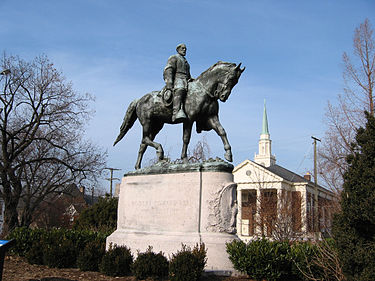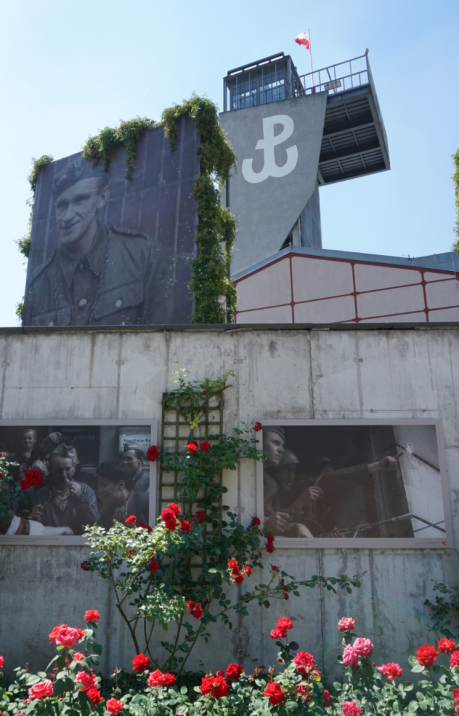By Abigail Costea, 2018 American Service Academies Program participant and first-class cadet at the United States Air Force Academy
The debate regarding Confederate statues and memorials is one that has risen to the forefront of American society in recent years. In the United States, the issue of removing Confederate statues is complex and unfortunately there have been only polarized solutions presented. While this debate has many different sides, it is one that requires extreme diligence and the utmost understanding of each side to ultimately resolve. After touring Poland through the American Service Academies Program (ASAP), specifically focusing on Holocaust era memorials, it crossed my mind that perhaps America needs to take a step back and truly understand this Confederate history from a different perspective…a perspective that is not only similar, but can be used as a foundation for building society and overcoming racial division. In this paper I argue that it is through an examination of history that America can gain insight and perspective as to why these statues ultimately need to be removed, studied and remembered in a different environment, such as a museum, rather than as a 40 foot piece of granite.
Before I break down my argument regarding the removal of Confederate statues and you perhaps think of simply closing your internet tab, I would like to preface this by saying that before immersing myself in the history of Poland in regards to the Holocaust, I believed that Civil War statues should remain standing. Being raised in Texas in a fairly conservative household and town, I held the same argument that many people have, primarily centered on wanting to keep the statues as they are history and removing them would essentially be erasing history. However, during my trip to Poland, I realized that my vision of how history should be remembered and valued in a society had shifted. I came to believe that removing statues isn’t erasing history, but rather is changing how we value certain aspects of history in a progressive society. While I understand the Holocaust and the Civil War are unique, there are some parallels that can be useful when considering the issue of memorials and monuments. I believe my argument addresses some of these important issues. I am not asking you to change your opinion if you believe that Civil War statues should remain standing. Instead, I would like to immerse you in a unique perspective that I gained from being a part of the 2018 ASAP.
One of the most prominent Civil War statues that has caused quite a controversy is the Robert E. Lee bronze equestrian statue in Emancipation Park in Charlottesville, Virginia. Robert E. Lee “served as a military officer in the U.S. Army, a West Point commandant and the legendary general of the Confederate Army during the American Civil War (1861-65)” (“Robert E. Lee”). While leading the Confederate Army, Lee held several opposing values and beliefs. One of those centered on fighting for states’ rights to own African American slaves. Lee was valued as a highly impressive leader and military officer. When his statue was commissioned in 1917 and later dedicated in 1924, it represented Lee as a prominent American figure for his role in the Civil War. However, what it failed to represent were the values that Lee stood for while earning his military recognition as the leader of the Confederate Army that are in no way representative of a progressive and united society. In a society that often remains divided, instead of being seen a military leader, many people see the statue as a constant reminder of America’s history of violence and racism present in today’s society.

While the statue is still standing, the controversy is far from dying down. Many protests, rallies, and marches have taken place, representing both sides of the argument that all statues should either be removed or kept standing. Notably, “A Virginia state law has stood in the way of the statue’s removal. That law prevents any national memorials from being removed. Despite city officials’ and lawmakers’ best attempts to remove the statues anyway, the law has held strong” (Burke). This law raises important questions about what it means that such a statue is considered a national memorial. If this law will prevent its removal, perhaps there are other ways to contextualize the history to ensure that visitors are aware of the challenges of the statue.
When touring Poland and learning about the history of the country, with a focus on the Holocaust, I noticed that memorials regarding history were presented in a far different context in comparison to Civil War commemorations. For example, on the first night in Poland, we stopped at the Mały Powstaniec, “The Little Insurrectionist” statue. This statue commemorated “the child soldiers who fought and died during the Warsaw Uprising of 1944” (“Mały Powstaniec”).

What struck me about this statue was that it represented a harsh and horrific time in history with poise. While this time in history for Poland was composed of division and longing for stability, the statue represents the somber struggle of Polish children who were called upon to fight. Amidst its representation of the negativity of both Nazi Germany and Soviet control, it focused its memorialization on the brave children who defied the odds and fought for themselves and their families.
Throughout our trip, we visited many different memorial sites and statues all of which represented history in a way that I interpreted as promoting progress in terms of unity rather than hindering society through division. Specifically, I found that the memorials we encountered drew attention to collective efforts to fight for Polish freedom, such as the Little Insurrectionist, rather than specific leaders of the resistance movement during World War II. One example of this is the symbol of a ‘P’ with an anchor, which can be seen throughout the city of Warsaw. This symbol represents the Home Army, the Armia Krajowa, which was the non-Jewish Polish resistance movement during World War II. The P with an anchor expresses collective resistance, persistence, and courage against occupation and highlights the active response of Polish people. This seems in stark contrast to Confederate monuments in the United States that commemorate a war within the population with a leadership figure who stood for division, not unity.

When comparing these two approaches to commemorating history, I realized more clearly than ever that history can be represented in different lights. I recognize that memorials are often biased, but my impression of Polish memorials was an emphasis on fighting for Polish values and a free nation, rather than celebrating leaders who held values in conflict with those we adhere to today.
Perhaps we can learn from Poland’s memorials of World War II and consider another way to commemorate the history of the Civil War. Many of the Confederate statues under debate highlight, and literally put on a pedestal, a historical figure whose values are in conflict with progressive ideals, and instead, are representative of division between black and white citizens of America. I believe that more weight should be given to the fact that statues such as Robert E. Lee’s in Charlottesville were put up in a time period in which division of races was acceptable and legal, more specifically, during the Jim Crow era which included “any of the laws that enforced racial segregation in the South between the end of Reconstruction in 1877 and the beginning of the civil rights movement in the 1950s” (Urofsky).
However, when one takes time to step back, we must ask ourselves why we, as a society, allow a statue of such a figure to continue to stand? Despite any leadership in Lee that society might admire, our current-day awareness of inequity and injustice toward African Americans leads me to call for removal of the monument. I believe each of us must ask ourselves: did the person memorialized use their leadership for the greater good of society? Perhaps they believed so at the time, but how do we address these memorials when they represent individuals whose values are not in concert with those we as a society prioritize today? With that being said, why would we entertain the idea of idolizing someone whose values do not align with today’s society? We must move forward instead of being stuck in the past.
While I do believe that Civil War statues praising historical figures that fought to promote racial division should be removed, I do not believe they should completely be forgotten. Just as in Poland and Germany, the fact that they do not commemorate the Holocaust with statues of Hitler, Himmler, or Heydrich, does not mean the history of the Holocaust is forgotten.
I propose creating a new Civil War museum, or adding to ones that already exist such as the National Civil War Museum in Harrisburg, Pennsylvania, that allows the public to view controversial statues with proper context, fostering critical analysis. Just as there are museums representing difficult histories, such as the African American History Museum and Holocaust museums in the United States, museums should continue to teach future generations about this history and include information about former leaders in their historical context. This is important because, as the philosopher George Santayana wrote, “those who do not learn from history are doomed to repeat it.” Museums such as these allow people who are genuinely interested in history to have the opportunity to visit, but to also think about leaders in context.
As a society, we must step back and look at this controversial perspective from many different lenses to ensure that we are doing what is best for our country. I could never imagine what it would be like if a Jewish person had to encounter a statue of Hitler on their way to school or work. Lee fought to hinder African Americans’ civil rights, and therefore I empathize with African Americans having to face these statues idolizing men who fought for slavery. On the ASAP trip, Air Force Cadet Marcus Brinker said something that will forever stick in my mind: “The Holocaust ended nearly 73 years ago and Germany has taken full responsibility for the Holocaust and is progressing, yet America is still divided from a Civil War that ended nearly 153 years ago.” We, as a society, must address inequities that have been in place since this era and remove Confederate statues that divide us from public spaces today.
Works Cited
Burke, Caroline. “The Fate Of Charlottesville’s Robert E. Lee Statue Is Still Up In The Air.” Bustle, Bustle, 10 Aug. 2018, www.bustle.com/p/was-the-robert-e-lee-statue-taken-down-in-charlottesville-the-debate-hasnt-fizzled-out-10050155.
“Mały Powstaniec.” Wikipedia, Wikimedia Foundation, 30 July 2018, en.wikipedia.org/wiki/Mały_Powstaniec.
“Robert E. Lee.” History.com, A&E Television Networks, 15 July 2018, www.history.com/topics/american-civil-war/robert-e-lee.
Urofsky, Melvin I. “Jim Crow Law.” Encyclopedia Britannica, Encyclopedia Britannica, Inc., 19 July 2017, www.britannica.com/event/Jim-Crow-law.
Abigail Ann Costea, a first-class cadet at the United States Air Force Academy, is from Waller, Texas and a graduate of Waller High School. She attended the United States Air Force Academy Preparatory School in 2015 and is currently a member of the Commandant’s and Dean’s List. She holds a position on the Class of 2019 Class Cabinet and serves as the Ring Dance Cadet in Charge. Abigail is majoring in Behavioral Sciences and due to her passion for her major, was chosen to represent USAFA for a summer research program redesigning a leadership training program for a non-profit military company focused on child education. Abigail is also a member of the Schulte Assembly which focuses on the empowerment of women in a military setting. Additionally, she is a mentor for USAFA Preparatory School Cadet Candidates. She has earned her Parachutist Badge for completing five solo free fall jumps out of a plane and wishes to pursue a career in logistics readiness.
The Auschwitz Jewish Center is operated by the Museum in Oświęcim, Poland. For additional blog entries by and about the Auschwitz Jewish Center, please visit: https://mjhnyc.org/tag/ajc. All Winter 2018 newsletter articles are found here.